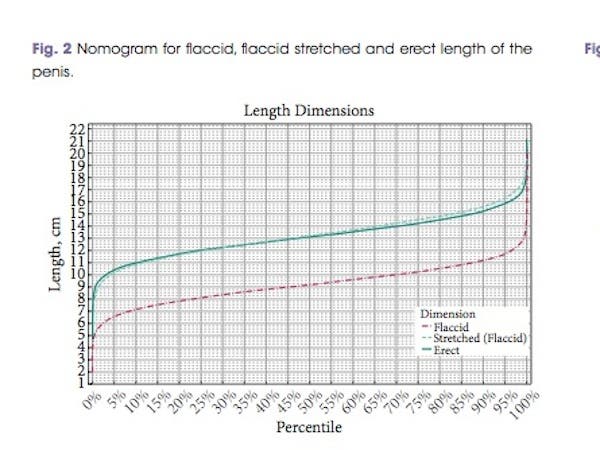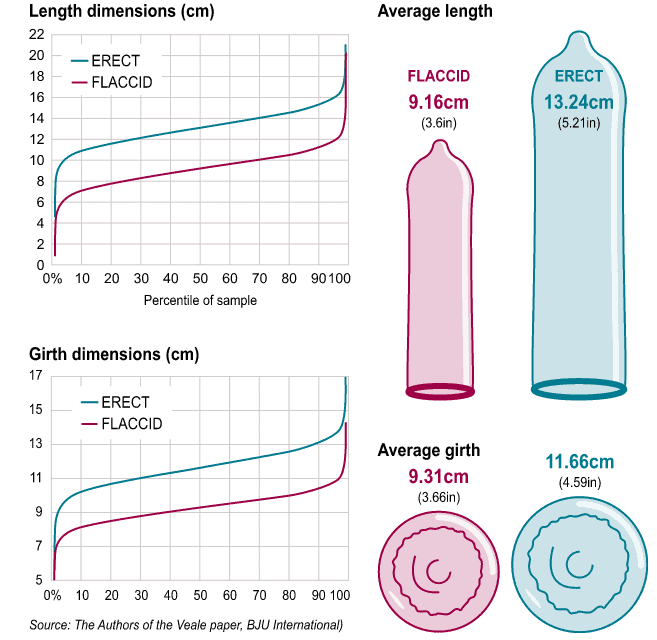Both men and women are often curious about the average penis size, though the former is probably more interested than the latter. However, Dr. Abraham Morgentaler took it to the next level. He conducted a study on over 15,000 men to create a chart of the average size – and the good news is, you’re probably better off than you think.
“Most men tend to believe they’re smaller than average, and there’s some distortion about what reality is,” says Morgentaler, director of Men’s Health Boston and author, most recently, of “The Truth About Men and Sex: Intimate Secrets From the Doctor’s Office.”
The study basically reviewed and summed up all the previous studies documenting penis size and girth; in the end, Morgentaler ended up with 15,521 data points from participants aged 17 to 91, who’d had their penises measured in 20 previously published studies carried out in Europe, Asia, Africa, and the United States. According to the study, just 2.28% of the male population have an abnormally small penis and as many have an unusually large one — the rest fit into a general curve, slowly dipping up.
Results
The study found that the average length during erection is 5.16 inches (13.12 centimeters) and the average flaccid length is 3.6 inches (9.16cm). As for the girth, the average value is 4.59 inches (11.66 cm) when erect, and 3.66 inches (9.31cm) when flaccid. What’s interesting is that if your penis is 11 cm, then you are in the low 10 percent – but if your penis is just 4 cm longer, that puts you in the high 15 percent – quite a significant jump for such a small difference, which seems to indicate that most penises are rather similar in size.
I have some even better news: the real average value might even be smaller than this study suggests. The studies were mostly conducted on volunteers, and there’s a good chance that those volunteers were quite confident in their characteristics(and therefore above average). But this is the best data we have.
“What’s interesting is, when you look at the curves, you see that most penises actually are fairly similar in size,” Dr. Morgentaler says. “You really have to go to the extremes — the top or bottom 5 or 10 percent — to really see some big differences. And truthfully, in my practice, I would say that’s exactly right. Most men have penises roughly the same size.”
Psychiatrists who carried out the study said they hope the findings could help men suffering from “small penis anxiety”. In his 26 years of experience as a urologist, Dr. Morgentaler has seen thousands of patients, and “probably there hasn’t been a single one who hasn’t paid attention to his penis size on some level,” he says. He also wants to dispel some of the commonly held myths regarding the male reproductive organ. For instance, the old myth is false — there’s no correlation between foot and penis size, nor is there between the penis and other extremities.
The study also found no correlation between penis size and race, but the majority of participants were European and Middle Eastern so it was quite difficult to make a thorough assessment.
Men’s penises are getting larger
You may think penis size stays constant, but that’s not the case. A new study found that men’s penises are actually getting longer in the past few decades, and the average erect penis has increased by around 25% in the past 30 years.
At the same time, however, the level of testosterone and sperm count in men is dropping concerningly, and it’s not clear if the two are connected.
Meanwhile, other studies suggest you really shouldn’t be concerned about penis size. Men tend to place much more emphasis on length than women do, and studies show that penis size tends to be less important for women. If anything, small studies suggest girth seems to be a more significant factor than length, but even that seems to be of secondary concern.
Recent research
Studies have suggested that most men think the average length of an erect penis is greater than 6 inches (15.24 cm) — a belief that is almost certainly misleading. This is based on myths but also on studies that rely on self-reporting; as you may guess, self-reporting penis size isn’t exactly accurate. Self-reporting studies also tend to suffer from volunteer bias: people who are more confident in their penis size are more likely to show up, which skews the data as well.
Based on studies that actually took measurements, the average length of an erect penis is between 5.1 and 5.5 inches (12.95-13.97 cm). However, after taking volunteer bias into account, the real figure is probably toward the lower end of this range, or even a bit lower.
Other recent studies have found that the average erect length is 12.9 cm, and it’s hard to link penis size to other physical characteristics.
So overall, while it’s hard to draw any clear conclusions, the measured values of around 5.1 inches (12.95 cm) seem closer to reality than the self-reported measures.
Of course, the average penis size also varies by country, but it’s hard to get precise measurements, and despite some recent research, there are still a lot of pervasive myths. But if you’re worried about this, here’s something you should also know: it’s probably all in your head. Studies have found that penis anxiety and penis size are not really well correlated, and men tend to worry regardless of what’s in their pants. Furthermore, women seem to be far less concerned about penis size than men and in fact, many women have ambivalent feelings about penis size. So if you’re worried about penis size, here’s what you need to know: it’s all in your head. Don’t worry about it and focus on the things that really matter.
Journal Reference: David Veale, Sarah Miles, Sally Bramley, Gordon Muir and John Hodsoll. Am I normal? A systematic review and construction of nomograms for flaccid and erect penis length and circumference in up to 15 521 men. DOI: 10.1111/bju.13010








